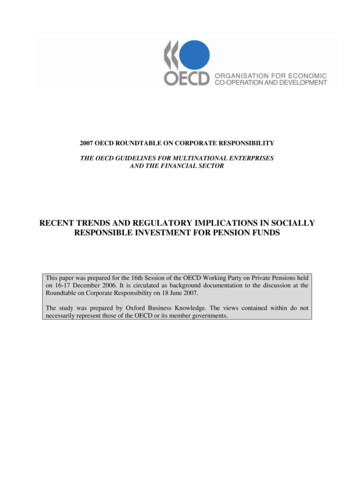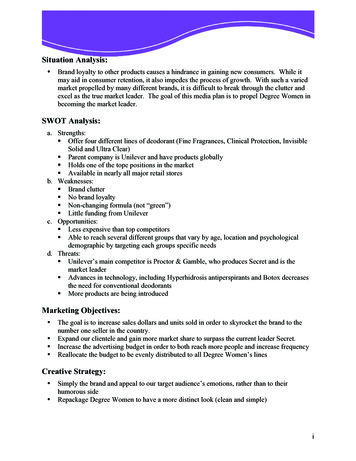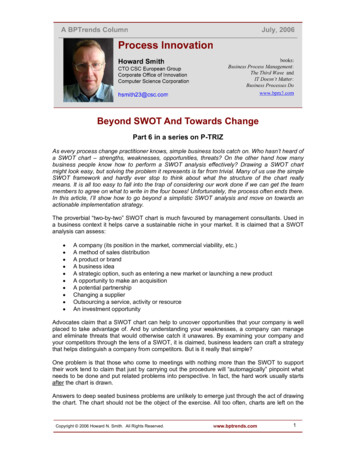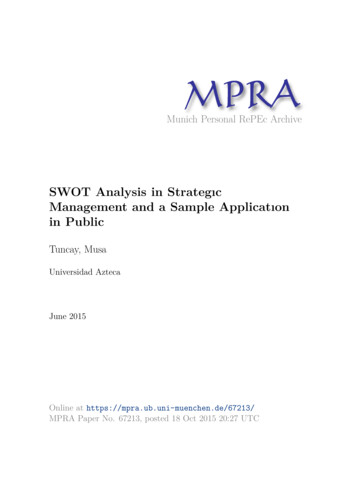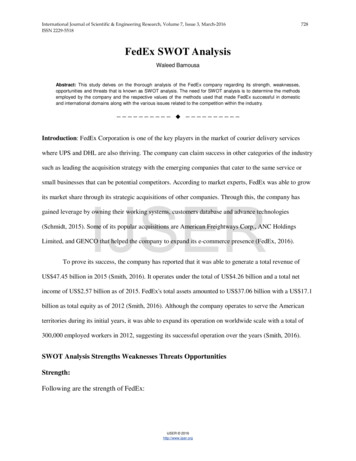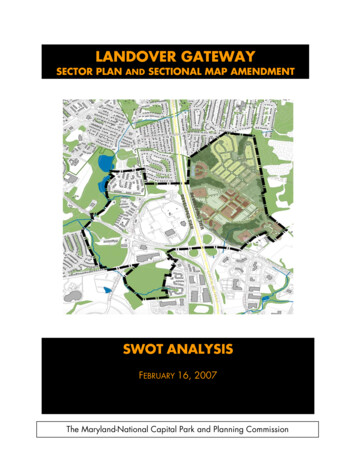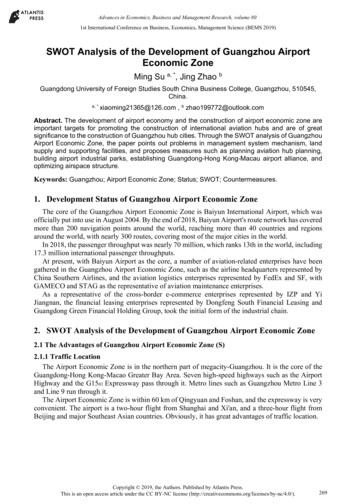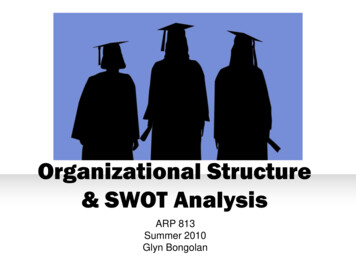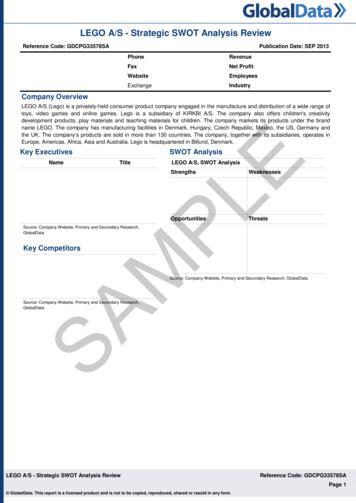
Transcription
Bulletin of Environment, Pharmacology and Life SciencesBull. Env. Pharmacol. Life Sci., Vol 7 [6] May 2018 : 107-116 2018 Academy for Environment and Life Sciences, IndiaOnline ISSN 2277-1808Journal’s URL:http://www.bepls.comCODEN: BEPLADGlobal Impact Factor 0.876Universal Impact Factor 0.9804NAAS Rating 4.95REVIEW ARTICLEOPEN ACCESSRecent Trends and SWOT Analysis of Food-Processing IndustryInfrastructure in India: A ReviewAjeet Sarathe 1 , Rajesh Gupta 2* , A.L. Basediya 3 and Venkata Satish Kuchi 4Professor, Department of Agricultural Engineering, AKS University, Satna (M.P.)2 Scientist, RVSKVV, KVK, Mandsaur (M.P.), 3 Scientist, RVSKVV, KVK, Shivpuri (M.P.)4 Department of Post Harvest Technology, College of Horticulture, Dr. Y.S.R. Horticultural University,Anantharajupeta, Kadapa District, Andhra Pradesh-516105, India.*Correspondence Author E-mail: rajeshgupta171@rediffmail.com1 AssistantABSTRACTEconomic growth, urbanization, increasing labour force participation of women and associated changes in lifestyleshave contributed to the rise of the food processing industry relative to other sectors. Food processing sector isindispensable for the overall development of an economy as it provides a vital linkage and synergy between theagriculture and industry. It helps to diversify and commercialize farming; enhance income of farmers; create markets forexport of agro foods as well as generate greater employment opportunities. Food processing or Agro-processing is atechno-economical process carried out for conservation and handling of agricultural produce to make it usable as food,feed, fibre, fuel or industrial raw material. Food and Agro-processing industry refers to the subset of manufacturing thatprocesses raw materials and immediate products derived from the agricultural sector. Food-processing industry thusmeans transforming products originating from agriculture, forestry and fisheries. Across the world, food-processing isconsidered to be a sunrise sector because of its large potential for growth and socio economic impact. It not only leads toincome generation but also helps in reduction of wastage, value addition, and foreign exchange earnings and enhancingmanufacturing competitiveness. The main aim of this study is to throw light on the present scenario of the industry inthe country and to find the opportunities and challenges faced by the industry in India. The study will also try to pointout the issues that need to be tackled to make global food processing industry globally competitive.Received: 4.01.2018Revised: 02.02.2018Accepted: 25.02.2018INTRODUCTIONFood processing industry is of enormous significance for India's development because of the vitallinkages and synergies it promotes between the two pillars of our economy, industry and agriculture. Fastgrowth in the food processing sector and simultaneous improvement in the development of value chainare also of great importance to achieve favorable terms of trade for Indian agriculture both in thedomestic and the international markets. The sector however has to go a long way. Even important is thecrucial contribution that an efficient food processing industry could make in the nation's food security forinstance the post-harvest losses of cereals are 10 to 18 percent and fruits and vegetables are about 25 to30 percent in our country. Even marginal reductions in these losses are bound to give us better returnsand thereby improve the income level of the farmers [1-5].During the last decade, India moved from a position of scarcity to surplus in food. Given the trade inproduction of food commodities, the Food Processing Industry in India is on an assured track of growthand profitability. It is expected to attract phenomenal investment in capital, human, technological andfinancial areas. The total food production of India is estimated to double in the next ten years. Hencethere is an opportunity for large investments in food and food processing technologies, skills andequipment. The major interventions in this context are, for example, Canning, Dairy and Food Processing,Specialty Processing, Packaging, Frozen Food / Refrigeration and Thermo Processing. Fruits andvegetables, fisheries, milk and milk products, meat and poultry, packaged /convenience foods, alcoholicbeverages and soft drinks and grains. Health food and health food supplements are other rapidly risingsegments of this industry [6].BEPLS Vol 7 [6] May 2018107 P a g e 2018 AELS, INDIA
Sarathe et alThe Food Processing Industry sector in India has been accorded high priority by the Government of India,with a number of fiscal relief and incentives, to encourage commercialization and value addition. As per astudy conducted by McKinsey and Confederation of Indian Industry (CII), the turnover of the total foodmarket is approximately Rs.2.5 Lakh crores out of which value-added food products comprise Rs.80,000crores [7-9]. The liberalization of the Indian economy and world trade and rising consumer prosperityhas thrown up new opportunities for diversification in the food-processing sector and opened new vistasfor growth. A study has revealed that there is tremendous potential in India to build a profitable businessin the sector. This industry ranks fifth in the country and employs 16 lakh workers, comprising 19 percent of the country’s industrial labour force. It accounts for 14 per cent of the total industry output with5.5 per cent of the GDP. Its turnover is estimated at Rs.1,44,000 crore, of which Rs.1,11,200 crore is in theunorganised sector. The industry has started producing many new items like ready-to-eat food,beverages, processed and frozen fruit and vegetable products, marine and meat products, IQF products,etc. [10]. The Indian consumer is being fast introduced to newer high quality food products made by usingthe latest state-of-the-art technology that is also giving the industry a competitive edge.DEFINITION OF FOOD PROCESSINGThe need for defining what should be construed as Food Processing was necessary because of differentclassifications by various departments/organizations (Ministry of Statistics and ProgrammeImplementation, DGCI&S, DIPP etc.) on what Food Processing includes. Since this ministry has to compilethe data from all such sources, there is a need for conceptual clarity on food processing. Henceforth thisMinistry will include under food processing industries, items pertaining to these two processes viz.(a) Manufactured Processes: If any raw product of agriculture, animal husbandry or fisheries istransformed through a process [involving employees, power, machines or money] in such a way that itsoriginal physical properties undergo a change and if the transformed product is edible and hascommercial value, then it comes within the domain of Food Processing Industries and(b) Other Value-Added Processes: Hence, if there is significant value addition (increased shelf life, shelledand ready for consumption etc.) such produce also comes under food processing, even if it does notundergo manufacturing processes.5Need of Food Processing Industry:India produces about 600 million tons of raw food materials of plant and animal origin which are refined,stored and transformed into various usable products using conventional and modern postharvest andfood processing technology. It involves operations like cleaning, grading, drying, storage, milling,packaging, transport, marketing and utilization. At the end of each operation, value is added to theproduct. The lowest and the highest monetary values of a food commodity are, respectively, when it is inraw and fresh form and when it is in processed and ready to consume form. Post harvest and foodprocessing technology are commodity and location specific. It enhances and augments per capita foodavailability form a unit arable land and other resources by preventing avoidable post harvest losses andadding value to the fresh agro-produces. It also creates opportunities for employment and incomegeneration. Integration of production agriculture with on-farm primary processing is needed to havehigher and sustainable production, productivity and better quality end products for domestic and exportmarkets. It, therefore, demands establishment of Agro Processing Centers in the production catchmentsitself to facilitate backward linkage with farmers, have fresh and best quality raw food materials forprocessing and value addition, minimize material movements, check migration of rural people to urbanareas for jobs and thereby reducing pressure on public utilities in urban areas. Such centre would be avery strong tool for rural reconstruction and its upliftment. It would help in reducing rural urbandisparity and ensuring household food and nutritional security for all at an affordable cost.The technology is available but political will and commitment is required to implement the program toshape a new India in the new millennium where everyone would be healthy and happy. It is in theinterest of the nation and its people. In India, the post-harvest losses are to the tune of Rs. 92,651 crore( 13 billion USD) per annum, giving out a gruesome picture of industry. A substantial amount of theselosses could be prevented if appropriate agro-processing centers having backward linkage with farmersto ensure constant supply of quality raw food materials are established and operated. The two majorgoals of Post harvest technology are loss prevention and value addition to the raw food commoditiesthrough preservation and processing. Raw food materials are cleaned, graded and then they are eitherstored or processed. Processing is done to make raw commodities edible through primary and secondaryprocessing and ready to eat through tertiary processing. Estimated value additions to the raw foodmaterials through primary and secondary/tertiary processing in India are 75 per cent and 25 per centrespectively (www.ibef.org). Now, we will explore some of the conventional and improved agroprocessing technologies which are used in food processing industry. Indian food processing industry isBEPLS Vol 7 [6] May 2018108 P a g e 2018 AELS, INDIA
Sarathe et algrowing at a healthy rate, and two sectors which are driving the growth are dairy sector and horticulturesector.Processed Food:Disease reduction is an important benefit of food processing. As raw food begins to rot or spoil, itbecomes contaminated by molds and bacteria that may cause you to get sick. Processing methods destroythose harmful pathogens. Processing foods also makes it possible for manufacturers to provideconsumers with a greater variety of foods. The people can enjoy processed food items that are out-ofseason or not native to the region. Processed foods are also easy to prepare and less time consuming thanmaking a dish from scratch. The United States Federal Food, Drug and Cosmetic Act, Section 201, Chapter IIdefines processed food as "any food other than a raw agricultural commodity and includes any rawagricultural commodity that has been subject to processing, such as canning, cooking, freezing, dehydration,or milling." This definition establishes parameters for the Food and Drug Administration to regulatequality and safety in the food processing industry. In consuming processed foods, consider whether thebenefits outweigh the potential negative effects of food additives such as sweeteners, salts, artificialflavors and colorings, factory created unhealthy fats and chemical preservatives. Too much sodium canlead to serious consequences such as high blood pressure. Processed foods also often contain excessiveamounts of sweeteners, fat and salt. These enhancements may encourage you to eat greater quantities offoods that have been stripped of valuable nutrients such as fiber, healthy fats and antioxidants, which aresubstances found in foods that can help prevent disease.Food processing is a procedure in which food is prepared for consumption. People often use this term torefer specifically to making packaged foods, but technically anything which transforms raw ingredientsinto something else is a form of food processing, ranging from grilling vegetables in the back yard tomaking television dinners in a food manufacturing facility. The sector focused on processing foodemploys large numbers of people, many of whom are unskilled laborers [18].There are several purposes to food processing. The most basic goal is to prepare food which is palatable.This can include processing ingredients which are not safe to eat raw, flavoring foods to make them moreinteresting, and making dishes which comply with cultural and religions norms surrounding food, inaddition to addressing issues such as allergies. Processing food is also usually intended to make foodwhich is nutritious, and can include activities such as food fortification, in which vitamins and mineralsare added to food during processing to increase the nutritional value. Safety is also a major concern infood processing, especially industrial processing to create packaged foods which are sold commercially.These facilities can be easily contaminated and the contamination can quickly spread, causing widespreadillness. Part of making food safe includes processing it to remove any potential risks, such as bacteria inmilk, in addition to maintaining strict safety procedures to reduce the risk of introducing harmfulorganisms during processing.Highly processed foods:Highly processed foods are made from combinations of unprocessed food, minimally processed food andprocessed food ingredients. Many are designed with consumer convenience in mind. They are oftenportable, can be eaten anywhere and require little or no preparation. Discussions of processed foods inthe popular media often refer to products in this category. Highly processed foods include snacks anddesserts, such as cereal bars, biscuits, chips, cakes and pastries, ice cream and soft drinks; as well asbreads, pasta, breakfast cereals and infant formula. High
Recent Trends and SWOT Analysis of Food-Processing Industry Infrastructure in India: A Review Ajeet Sarathe1, Rajesh Gupta2*, A.L. Basediya3 4and Venkata Satish Kuchi 1Assistant Professor,Department of Agricultural Engineering, AKS University, Satna (M.P.) 2Scientist, RVSKVV, KVK, Mandsaur (M.P.), 3Scientist, RVSKVV, KVK, Shivpuri (M.P.)
